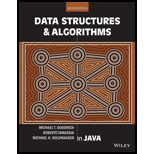
Concept explainers
Explanation of Solution
Recursive method to determine the sum of two elements is equal to “n”:
Create the method checkSum() that accepts the input parameter as “A”, “j”, and “k” to determine the sum of two elements in an array “A” is equal to “A[i]” by calling this method recursively.
Method definition:
//Define the checkSum() method
public static boolean checkSum(int A[], int j, int k)
{
//Loop executes until the array length
for (int i = 0; i < A.length; i++)
{
//Check whether "j" and "k" is less than "i"
if((i > j) && (k < i))
{
/*Check whether sum of "A[j]" and "A[k]" is equal to "A[i]". */
if (A[i] == A[j] + A[k])
{
/*Return true, if there are elements in array "A" that sum is equal to "A[i]". */
return true;
}
}
}
//Check whether "k+1" is equal to length of array
if (k + 1 == A.length)
{
/*Check whether "j+1" is less than to length of array. */
if (j + 1 < A.length)
{
/*Call checkSum() method recursively by passing the parameters as "A", "j+1", and "0" to sum the two elements is equal to "A[i]" and return it */
return checkSum(A, j + 1, 0);
}
/*Return true, if there are no elements in array "A" that sum is equal to "A[i]"...
Trending nowThis is a popular solution!

Chapter 5 Solutions
Data Structures and Algorithms in Java
- Please solve and answer the questions correctly please. Thank you!!arrow_forwardConsidering the TM example of binary sum ( see attached)do the step-by-step of execution for the binary numbers 1101 and 11. Feel free to use the Formal Language Editor Tool to execute it; Write it down the current state of the tape (including the head position) and indicate the current state of the TM at each step.arrow_forwardI need help on inculding additonal code where I can can do the opposite code of MatLab, where the function of t that I enter becomes the result of F(t), in other words, turning the time-domain f(t) into the frequency-domain function F(s):arrow_forward
 C++ Programming: From Problem Analysis to Program...Computer ScienceISBN:9781337102087Author:D. S. MalikPublisher:Cengage Learning
C++ Programming: From Problem Analysis to Program...Computer ScienceISBN:9781337102087Author:D. S. MalikPublisher:Cengage Learning Systems ArchitectureComputer ScienceISBN:9781305080195Author:Stephen D. BurdPublisher:Cengage LearningProgramming Logic & Design ComprehensiveComputer ScienceISBN:9781337669405Author:FARRELLPublisher:Cengage
Systems ArchitectureComputer ScienceISBN:9781305080195Author:Stephen D. BurdPublisher:Cengage LearningProgramming Logic & Design ComprehensiveComputer ScienceISBN:9781337669405Author:FARRELLPublisher:Cengage New Perspectives on HTML5, CSS3, and JavaScriptComputer ScienceISBN:9781305503922Author:Patrick M. CareyPublisher:Cengage Learning
New Perspectives on HTML5, CSS3, and JavaScriptComputer ScienceISBN:9781305503922Author:Patrick M. CareyPublisher:Cengage Learning C++ for Engineers and ScientistsComputer ScienceISBN:9781133187844Author:Bronson, Gary J.Publisher:Course Technology Ptr
C++ for Engineers and ScientistsComputer ScienceISBN:9781133187844Author:Bronson, Gary J.Publisher:Course Technology Ptr EBK JAVA PROGRAMMINGComputer ScienceISBN:9781337671385Author:FARRELLPublisher:CENGAGE LEARNING - CONSIGNMENT
EBK JAVA PROGRAMMINGComputer ScienceISBN:9781337671385Author:FARRELLPublisher:CENGAGE LEARNING - CONSIGNMENT





